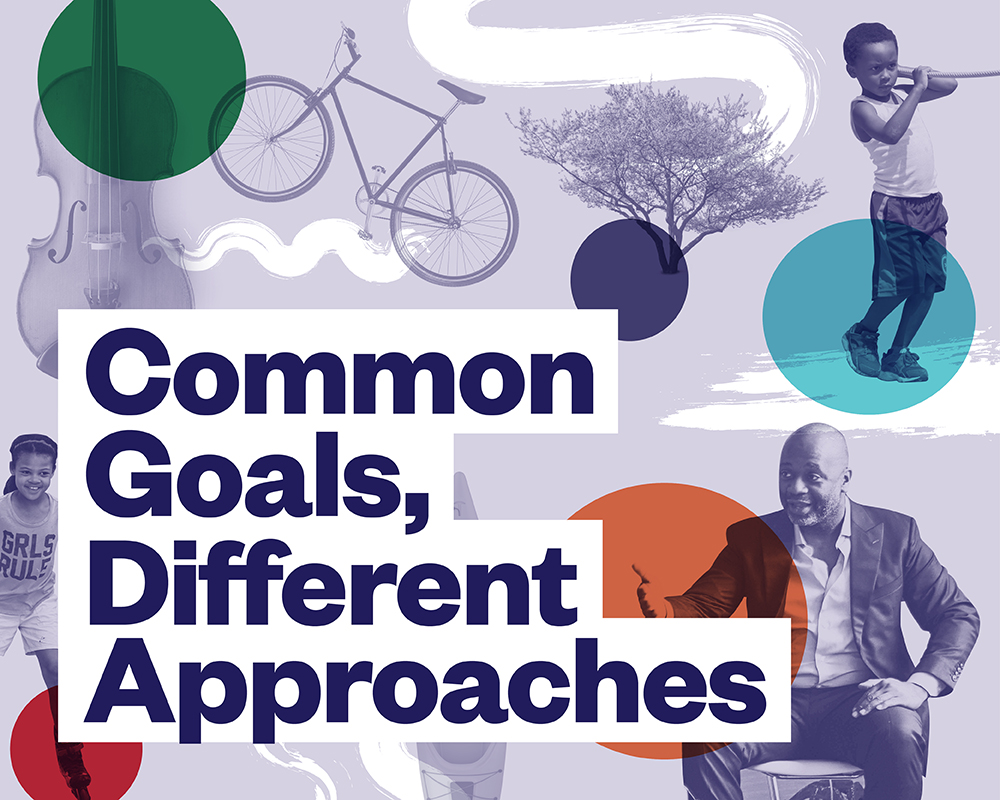Learn more about the report, “Common Goals, Different Approaches,” by reading this blog and the press release.
Introduction
In his 2018 book “The Divided City,” the urban scholar Alan Mallach wrote, “America’s once industrial and now postindustrial cities appear to be on a trajectory to a future in which they become more and more polarized places where bustling, glittering enclaves of prosperity are ringed by declining or largely abandoned areas, and where millions are relegated to lives of poverty and hopelessness.” The American city—which seemed bound for devastation in the 1960s and 1970s and revival in the 2000s—is now on a path toward greater socioeconomic division. And for all the talk of wildly rising costs and metastasizing luxury condos in cities like New York and San Francisco, there are far more places, such as Detroit’s Fitzgerald, Akron’s Summit Lake and Philadelphia’s Strawberry Mansion, that were once stable middleclass neighborhoods but have long been sliding toward disinvestment, neglect and isolation.
The public sector has struggled to halt this slide and connect residents of underresourced neighborhoods to opportunities in thriving areas nearby. It’s an incredibly challenging task, given all the factors at play: economic forces, a history of racial discrimination, poor transit connections, housing inequality, educational shortcomings and a lack of quality public gathering spaces, to name a few. But four foundations have come together to launch an important experiment in breaking down some of these barriers. What would happen, they asked, if a small group of cities received funding to transform a few public spaces each into places where different groups of people could mingle, where investment inequities were rectified, where environmental stewardship and sustainable transit connections were a priority, and where local residents could claim a degree of ownership? If each city were left to its own devices, how would it structure its projects, in terms of leadership, site selection, community engagement, redevelopment strategies and goals? And how would those decisions affect the outcomes?
Reimagining the Civic Commons is an attempt to answer those questions. This three-year national initiative was launched in 2016 with the announcement of a $40 million investment in public spaces in four cities: Detroit; Memphis, Tennessee; Akron, Ohio; and Chicago. The four foundations—the JPB Foundation, the John S. and James L. Knight Foundation, The Kresge Foundation and The Rockefeller Foundation—invested half of the total, with matching funds from local sources. (In a fifth city, Philadelphia, a pilot program that started in 2015 was supported by Knight and the William Penn Foundation.)
Most of the cities are now more than two-thirds of the way through their Civic Commons grant periods, and while much of the work
remains to be done, their projects have taken shape in concrete and meaningful ways. The disparate approaches chosen by the five cities, and the mix of successes and challenges they’ve encountered, show clearly that there’s no simple right or wrong answer to the question of how to create a better civic commons. Instead, they offer different lessons for further efforts, by cities and the partners that support them, to create a richer, fairer, more sustainable and more integrated urban landscape in the future.

Philadelphia: The Pilot: Confronting challenges of geography and community engagement
Ask the leaders of Philadelphia’s Reimagining the Civic Commons initiative what the project’s unifying goal is, and you’ll get as many different answers, from “create these legendary public spaces” (Jamie Gauthier, former executive director for the Fairmount Park Conservancy) to “exploring what public spaces do, not just that they exist” (Patrick J. Morgan, former Philadelphia program director for Knight Foundation) to “it’s less about the projects and more of an idea” (city Commissioner of Parks & Recreation Kathryn Ott Lovell).
Of the five Civic Commons cities, Philadelphia is the outlier. It was the pilot city, and it’s the only one whose grant period is over. Its sites are spread across the city: You would have to travel more than 20 miles to visit them all. And where Memphis is focused on its riverfront and Detroit on one neighborhood, Philly tackled a library, a recreation trail, a park, an old rail line and a new lakeside office building. It’s all over the place, both geographically and conceptually.
Mixed into that complicated assemblage is some great success. Bartram’s Garden is widely hailed across the Civic Commons network as the initiative’s model site; it broke down the perceived barriers between a natural landmark and a neglected neighborhood and made residents feel welcome for the first time. Centennial Commons is bringing investment and programming to a park that lacked both—the park’s inaugural public movie screening, of “Black Panther,” turned out a small but delighted crowd of neighbors—and the Discovery Center is likely to do the same for East Fairmount Park. The Rail Park could be a transformative project that re establishes forgotten connections across the city.
Now that Philadelphia’s Civic Commons grant has expired, the team is applying the lessons of the initiative to other projects in the city—most notably Rebuilding Community Infrastructure (Rebuild), a $500 million citywide neighborhood revitalization program funded largely through a soda tax—and to share them with the Civic Commons cities whose work is ongoing. All of that requires a deep examination of what Philly got right and what it got wrong.

Detroit: Redefining Assets: A city on the rebound turns mass vacancy to its advantage
On the wall of his office, Maurice Cox has pinned a map of Detroit that’s colored like Christmas. Each property in the city is marked red or green— red for occupied, green for vacant, although you could be forgiven for guessing the inverse, since there are at least as many overwhelmingly green patches as red ones.
Downtown Detroit is a block of near-solid red. You don’t need the map to tell you that: Cox’s window looks out onto a dazzling array of skyscrapers connected by a network of footbridges. Radiating from downtown on the map, however, are streaks of green. And 9 miles northwest of downtown is a perfect square dominated by green.
This square is the heart of the Fitzgerald neighborhood. And it’s where Cox, Detroit’s planning director, is focusing a lot of his energy.
Vacancy and blight have plagued Detroit since its steady decades-long decline—precipitated by suburbanization, white flight, riots and the erosion of auto industry jobs—brought the city to its nadir, culminating in its 2013 bankruptcy. Between 2004 and 2014 alone, Detroit lost 244,000 people, enough to form Michigan’s second-largest city. What makes the Fitzgerald project particularly important for Detroit—and different from the other initiatives in the Civic Commons network—is that it’s redefining vacancy as an asset. Other Civic Commons cities have focused on building new assets or restoring old ones. But Cox and his team are taking something that has always been seen as a negative and trying to turn it into a positive.
The view out Cox’s window frames the city’s most obvious asset: the revitalization of downtown Detroit. It began with investments in Detroit’s riverfront and Campus Martius Park in the early 2000s and rapidly accelerated when Dan Gilbert moved his mortgage company, Quicken Loans, into downtown in 2010, purchased a slew of office buildings nearby and lured other businesses to the downtown core. Now, on a warm summer evening, you can find groups of business travelers in work attire hopping between downtown’s high-end restaurants and bars, and large numbers of locals strolling along the pristine RiverWalk, with sweeping views of Canada across the Detroit River. To the north, in Midtown, hipsters and young professionals patronize breweries, boutiques and museums.
The success of Detroit’s downtown differentiates it from other Civic Commons cities, such as Memphis, which is focusing its efforts on downtown to restore the city’s center and sense of place, and Akron, which is putting resources into downtown and seeking to connect it with areas that have more population and off-hours foot traffic.
The recovery of downtown Detroit is well underway. It serves as a visible reminder of what Detroit writ large could be, and of what it used to be, before the city of 1.85 million was reduced to a 670,000-person shell. The goal now is to help the recovery spread throughout the city. The Civic Commons project in Fitzgerald is, more than anything, an effort to revive a sagging neighborhood and give it attractive public amenities it has long lacked. But it’s also a proof of concept for the rest of the city. If vacancy can become an asset in this quarter square mile, can it also be used to revive Detroit?

Memphis: Rewriting the Narrative: Addressing a complicated history through a riverfront revitalization
The kayak race was, by any normal standard, a modest one. The dozen or so participants paddled at a leisurely pace. One had the advantage of a coxswain aboard—a dog in a bright green life vest, perched on the prow—but still trailed the pack. A drone captured footage of the contest for all of 30 seconds before crashing into a pedestrian bridge, breaking in two and plummeting into the river.
But for Carol Coletta, president of the Memphis River Parks Partnership, the mere presence of all these kayaks in the Wolf River Harbor, an offshoot of the Mississippi, was cause for celebration. “Look at these people!” she exclaimed. “This is great!”
The Memphis riverfront’s journey to this moment proceeded about as quickly as the Wolf River Harbor’s languid current. There was a time when the river put Memphis on the map; when the commerce it brought made the city the world’s top market for cotton, hardwood and mules; when the adjacent downtown flourished and grew. Then steamboats and mules were supplanted by railroads and cars. The city’s center of gravity pulled eastward, toward the highways and the suburbs.
Downtown declined slowly, then suddenly, with a gunshot fired at the balcony outside Room 306 of the Lorraine Motel in 1968. “After Dr. King’s assassination, downtown Memphis died,” said Robert Montgomery, a member of the Downtown Memphis Commission’s Blue Suede Brigade, which provides security and assists visitors. The exodus of people from downtown was followed by an exodus of business, and blight and crime took their place.
Now, residents tell a consistent story: Sometime in the past 10 to 15 years, something started to change. Downtown began its comeback. But like the decline, it started slowly, almost imperceptibly. That’s why a small milestone like a kayak race seemed so significant.
Still, in the context of the surrounding areas, the downtown Memphis riverfront remains the laggard. “Our part of downtown is pretty sleepy in general,” said Maria Fuhrmann, the city’s grants coordinator and Civic Commons lead. “There’s nodes of activity to the north and south, but this is the missing middle.” As with Detroit’s Civic Commons project, which seeks to build an enlivened connection between two universities, the aim is to bridge those nodes and make the underserved center feel vibrant and valuable. It’s no coincidence that Detroit and Memphis are the two most segregated Civic Commons cities, where well-resourced areas can sandwich such underinvested ones.
Other recipients of Civic Commons grants focused on neighborhoods, buildings and parks that had been largely forgotten in the public consciousness. Memphis set its sights on its most obvious landmark: the riverfront. And Aug. 4, 2018, was its coming-out day.

Akron: Think Small: Aiming for bunts, not home runs, in community-driven planning
It seemed like such an everyday scene: Two women and their children walked down a small slope, sat on a pair of bench swings and looked out at Summit Lake. But captured in that tableau was the success of Akron’s Civic Commons strategy.
In a network with grand ambitions to transform the way urban communities interact with public spaces, Akron’s Civic Commons initiative could be summed up with a different sort of motto: Think small.
Not only is Akron the smallest Civic Commons city by far—at 197,000, its population is one-eighth of Philadelphia’s and one-fourteenth of Chicago’s— but it has intentionally shied away from grandiose projects. Where Memphis is seeking to reshape its riverfront, Detroit is transforming acres of vacant land into a major community asset and Chicago is aiming to change the way cities approach the arts, Akron asked Summit Lake residents what they wanted, and they said seating, tables and shade. So that’s what they got. And by restoring access to the lake and fulfilling those simple requests, the city did more to build trust than any monumental construction could have.
“I don’t think we ever went about this saying we were going to change the landscape of Akron,” said Dan Rice, president of the Ohio & Erie Canalway Coalition, which is leading Akron’s Civic Commons project.
Memphis, by contrast, has been tackling “a really giant project,” said Kyle Kutuchief, the Knight Foundation program officer in Akron. “And ours is really a sum of small parts.” There are improvements to a recreation trail. There are new activities in once-deserted downtown squares. And there are some very well-used picnic tables. Akron has tried for too long to hit grand slams, like huge development projects and efforts to fix the economy by luring big companies. Now, Kutuchief said, the city is going for “bunts and singles.”

Chicago: An Artist’s Vision: Theaster Gates’ art-fueled empire transforms a slice of the South Side
The musicians at the front of the room raised their instruments, paused and then launched into a rambunctious string quartet by the African-British composer Samuel Coleridge-Taylor.
The sound rang through the hall, an old bank lobby not designed for acoustics but very well-suited to the purpose. An ornate ceiling arched overhead, affording a peek at a soaring two-story library housing the personal collection of the legendary African-American publisher John H. Johnson, the late founder of Ebony and Jet magazines. An array of children sat on a rainbow of colorful pillows up front, while the grown-ups filled benches behind them, rapt and silent until they broke into applause.
The musicians, all black, announced their next piece. Like the others in the D-Composed series, it was by a black composer and under five minutes long. They invited the kids to clap and the adults to stomp to the beat as the violins soared and the cello plunked a rhythmic line.
Elsewhere across the Civic Commons network, cities are creating parks, libraries and trails. Chicago is different, in a few obvious and less obvious ways. Most apparent is the focus on the arts. String quartets have yet to feature in the other Civic Commons initiatives; here, they’re center stage— literally at the Stony Island Arts Bank, and figuratively at Chicago’s other sites, which all seek to foster artistic creation. Then there’s the person at the heart of it all, renowned South Side artist Theaster Gates. In the other cities, the projects are the product of extensive partnerships and collaboration, but Chicago’s projects are largely Gates’ brainchild. And where the project sites elsewhere are mostly owned by municipal governments or nonprofits working closely with the city, Gates himself controls most of the properties his team is working on.
Does that allow Gates to move the projects swiftly without waiting for government cooperation? “Absolutely not,” he said with a laugh. He still relies on the city and development partners, and he wishes he had sat down with the mayor at the beginning of the process to get buy-in and participation from these partners at the onset of the Civic Commons initiative.
But his ownership of the projects does allow him to do something different, and something he considers more valuable. “One of the things that neighborhoods need more of is autonomous local voices to determine an agenda that is not necessarily set by a municipal public,” he said. If the city controls a development project, it’s answerable to the will of voters, who are likely to want basic services like grocery stores. If a private developer does, it tries to maximize income, maybe by luring a national chain retailer. “My thinking is, there are other players who should try to determine the fabric,” he said. “And those players have different expertise than national interests.”
In this case, he’s the player. That comes with pitfalls, but also promise: Gates has a vision for the South Side of Chicago, one that Civic Commons is helping him realize more comprehensively than ever, and it’s beginning to transform a once-neglected neighborhood—or at least a small corner of it.
-
Community Impact / Article
-
Community Impact / Press Release



